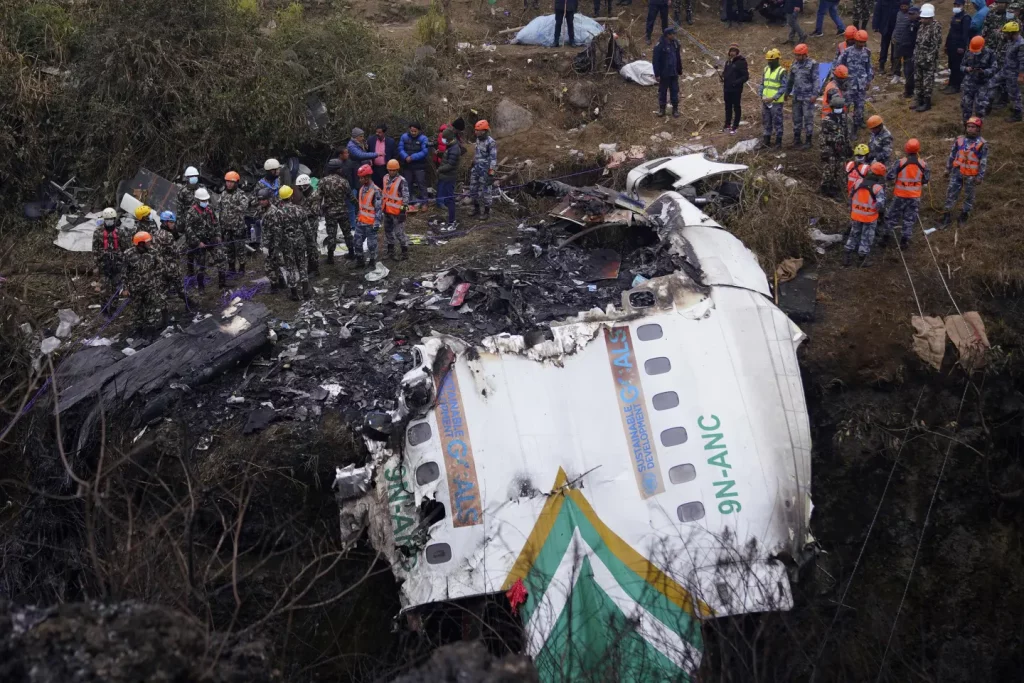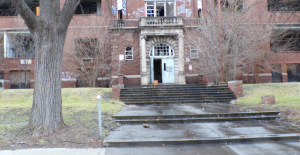
By David rising
Yeti Airlines Flight 691, which had travelled from Kathmandu for 27 minutes, crashed on Sunday, just moments before it was due to land in Pokhara in Nepal, a tourist destination and the entrance to the popular Himalayan hiking region.
The death toll of 69 out of 72 passengers on the flight has been confirmed.
Although flying is difficult in Nepal, the weather conditions were ideal at the time the accident occurred, as they included low winds, clear sky, and temperatures above freezing. What could have been the cause of the crash?
The dramatic footage was shot from the ground by a smartphone. It shows the final moments of the flight before it crashed into a ravine about 1.6 km (miles) away from Pokhara International Airport. Amit Singh is an experienced pilot from India and founder of Safety Matters Foundation. He says that despite the high nose of the aircraft, its left wing drops suddenly and it falls out of sight of the video. This indicates the likelihood of a stall.
The Associated Press reported that he told them the nose of the plane rises when it stalls. When the nose is raised, so does the speed. When they stall one of the wings goes down and then all lift is generated by their own wings. The lift produced by an aircraft decreases as airflow reduces. As a result, it is not enough to keep the plane in the air, so the nosedive and drop its wing.
Ron Bartsch is an aviation expert, founder of Avlaw Aviation Consulting and an expert in safety. He told Sydney’s Channel 9 that he believed the plane also stalled. The pilots might have believed their speed to be greater due to its close proximity.
After reviewing the video, just prior to the crash he said that the plane had been in an aerodynamic stall. “Possibly pilot error.”
Bartsch stated that despite several fatal accidents, many of which were due to icing problems, ATR-72 has generally had a “very positive track record.”
On Monday, investigators recovered a flight data recorder as well as a cockpit voice recording from the accident site. However, they won’t be able to determine what exactly happened until these recordings are carefully analyzed.
Bartsch stated that the investigators would examine human factors in order to establish whether proper training was provided. Bartsch said, “In normal circumstances aircraft don’t just drop out of the skies.”
Even if the instruments of the aircraft gave the pilots incorrect data, it’s still possible to recover after a stall.
He said that pilots need to be taught how to deal with technical problems.
Even though Nepal’s aviation sector has seen improvements in the last few years, its airspace is banned despite “challenging conditions and airports.”
A pilot flying an ATR-72-500 regularly from India to Nepal says that the narrow valleys and mountain peaks in the area increase the accident risk and force pilots to use their eyes instead of instruments.
A pilot in India who wanted to remain anonymous because of company policy called the ATR-72-500 an “unforgiving” aircraft if a pilot wasn’t well-versed and knowledgeable about the terrain and wind patterns.
ATR tweeted on Sunday that its experts were “fully committed to supporting both the investigation as well as the customer,” and their “first thoughts” are for the affected individuals.
No further comment was available from the company.
Safety Matters Foundation reports that there have been 42 plane accidents in Nepal fatalities since 1946. Eight of the 14 tallest mountains in the world are located within Nepal.
In 2019, the Nepal Civil Aviation Authority stated that Nepal had “hostile terrain” and “different weather patterns,” which caused “numerous accidents” for small aircraft. According to the report, most accidents happened at airports that had small runways due to pilot error.
Pokhara Airport, popular tourist destination, and the gateway to Annapurna Mountain Range, is situated at approximately 820 metres (2700 feet) above sea level.
Some people expressed concerns two weeks ago that proximity to two rivers and landfills near the airport could contribute to an increase in birds.
The local media reported the mayor of the city saying that work had been done to reduce the impact the landfill at the airport opening. However, it was not clear exactly what measures were taken.
Singh stated that a bird strike could have caused the pilots’ to abandon their approach, and then go around, which resulted in a stall.
According to him, high thrust settings can cause stalls. He said that crews often misuse go-arounds. So again, the question remains, how did pilot handle failure?
For more information about our weather-related services and how we can help you prepare for and mitigate the impacts of various weather conditions, please don’t hesitate to contact our expert team. We are here to address any questions you may have and provide you with detailed insights into the weather-specific solutions we offer.
From weather monitoring and forecasting to comprehensive disaster preparedness plans, and Weather damage restoration, our experienced professionals are well-equipped to handle a wide range of weather-related challenges. Whether it’s extreme weather events, hurricanes, storms, or other natural occurrences, we strive to use the latest technologies and industry best practices to safeguard your property and ensure your safety.
To learn more about our services or to discuss customized weather preparedness strategies tailored to your specific needs, please visit our website at https://ncrestoration.ca/. Our dedicated customer support team is available to assist you, offering guidance and support to ensure you have a smooth and secure experience with our weather-related services.
Your safety and the protection of your property are of utmost importance to us. Reach out to us today and discover why we are the trusted choice for weather-related solutions in Toronto. Let us work together to face the challenges posed by weather and create a resilient plan to weather any storm.






